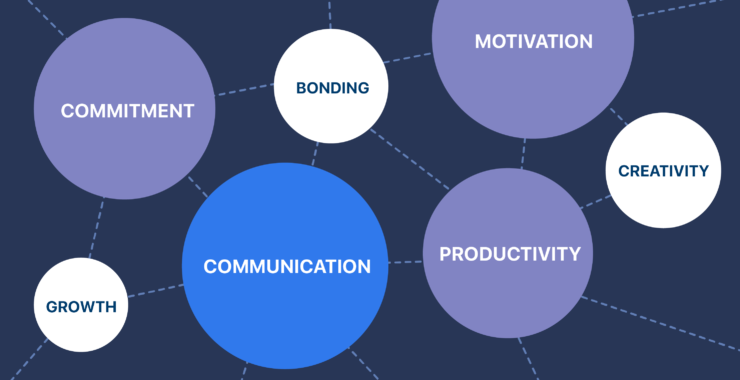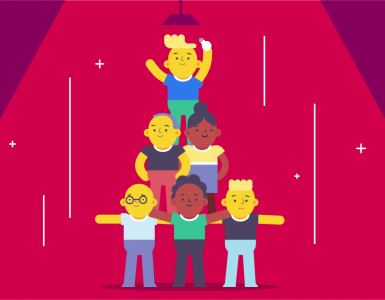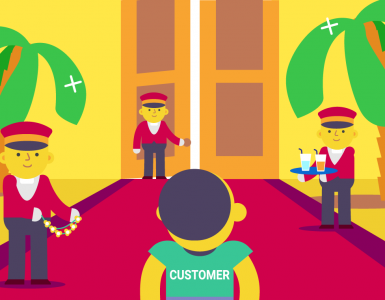Creating an environment that encourages collaboration is key to a successful company culture, but it’s also important to have a good balance of power on your team. You don’t want one person to feel like they’re being treated unfairly by the rest of the staff, but if everyone feels like they’re equal stakeholders, you’ll find yourself with a cohesive team that works together seamlessly.
The best way to achieve this is through dialogue. As long as people are speaking openly with each other and listening carefully, you’ll have a strong foundation for creating a healthy working relationship – one that will last for years to come!
You might’ve heard that teamwork makes the dream work, right? That’s an absolute truth in the business world. If you want to achieve success, you’ll have to ensure that your employees know how to connect with one another and work as a team.
When you make your team work well together, you can solve problems quickly and improve response time by a lot. But these team dynamics don’t just spring up naturally. You can’t just throw a bunch of people in a room and expect them to work their magic.
You have to foster team dynamics by keeping a strong focus on open and honest communication. But that’s a lot easier said than done. In this article, we’re going to give you actionable examples that you can use to create effective team dynamics.
Team dynamics vs group dynamics: Key differences
Before we look at how to improve team dynamics, it’s important to clarify the difference between team dynamics and group dynamics. While the terms ‘team‘ and ‘group‘ are often used interchangeably, there’s a key difference between the two.
A team is a cohesive unit where each member works together toward a common goal. Responsibilities are shared, and members are highly interdependent. Team dynamics focus on collaboration, trust, and communication, creating an environment where everyone contributes to achieving the shared objective. Strong team dynamics foster synergy, ensuring that the whole is greater than the sum of its parts.
On the other hand, group dynamics can refer to any collection of people who may or may not have a specific, shared goal. Groups tend to be less interdependent and members often work on their own tasks without the same level of collaboration. While group dynamics are important for managing interactions, they lack the strong sense of cohesion and shared responsibility that characterizes effective team dynamics.
Quick comparison:
| Feature | Team Dynamics | Group Dynamics |
|---|---|---|
| Goal | Shared common goal | Individual or no specific goal |
| Collaboration | High interdependence | Low interdependence |
| Accountability | Shared responsibilities | Individual responsibilities |
| Communication | Frequent and open | Limited or task-focused |
In short, team dynamics are about synergy, whereas group dynamics are more about individual roles coming together without necessarily working toward a common goal. To foster effective collaboration, it’s essential to transform a group into a team by focusing on shared goals, clear communication and mutual support.
Now that we’ve clarified the difference, let’s take a closer look at what team dynamics are and how important they are for effective teamwork.
What are team dynamics?
Team dynamics are the psychological connections that create bonds between team members and help them function as a unit.
But there are many factors that contribute to team dynamics, such as leadership, clearly defined roles, recognition, dialogue, communication, and more.
thekeepitsimple.com
The makeup of the modern workforce has made this even more difficult, with more than half of US workers contributing remotely at least once per week, according to Internet Advisor. That’s why it’s so vital for companies to build a culture and team dynamic that complement remote working conditions and fosters a sense of camaraderie among team members, regardless of office location. For example, integrating effective remote access tool helps build a flexible working environment that connects people and promotes collaboration between different departments and teams in different locations.
Before you start to change the way your team works, you should first figure out if the way it works now is good or bad.
Your team is exhibiting positive and effective team dynamics when you see:
- An understanding of individual roles and how those roles impact others
- Respectful and engaging debates that never descend into arguments
- Awareness and control over one’s personal behavior when interacting with the group
- Enhanced productivity surrounding meetings
Some red flags to watch out for include:
- Uncertainty after meetings
- Loud arguments
- Disrespectful language
- A lack of accountability and knowledge of individual roles
Now that you understand how team dynamics work, let’s dig into some specific examples of how you can improve your team dynamics going forward.
Examples of effective team dynamics
Set expectations
As a team leader, it’s up to you to set clear expectations and lay out what’s expected of every member individually and from the team as a whole.
This is best done in writing, whether that appears in an email or through a central platform that everyone can access (like a team chat app such as Chanty).
Your employee handbook and each employee’s job description should include your general rules for how they should act.
When it comes to project-specific dynamics, you might have to spell out a few things.
For example:
- Lay out a chart that shows the overall workflow of a project. Point out who’s responsible for which tasks, and what’s expected. This shows each individual how their work impacts the entire team
- Set expectations for meetings, including the amount of time they should take and how often they occur
- Set a code of professional conduct for team members when working together, including expectations around respect and dignity
- Layout communications expectations regarding reports given to management
- Show a clear chain of command so that everyone understands who they’re answering to
Encourage diversity
Diversity is vital to team dynamics because diverse opinions and viewpoints can shine new light on a project.
When your team is composed of many individuals who think in the same way, it creates a phenomenon called “groupthink,” which you should avoid at all costs. You want to ensure that diverse individuals are contributing creative ideas and that those ideas are being heard and considered by the group.
wikipedia.org
You can practically ensure this by pairing up different types of people, mixing and matching them based on personality type to find effective combos.
Different personality types thrive in different roles within a team. For example, INFJ personalities do better in more independent roles, while their more extroverted counterparts thrive on being in socially interactive roles.
When you assign teams for various projects, keep track of how well these pairings work together and whether there are any communication issues. Also, keep track of how long it takes them to come to decisions and if all deadlines are being met.
Talk with your team members afterward, and ask them if they feel their ideas and input were considered.
Lead by example
Your leadership dynamics will inform the team dynamics of your staff. In other words, if you’re not an effective leader and display poor communication skills, your employees will take a cue from you and perform equally bad or worse.
That’s why you must pay attention to how you communicate with your team members. You’re in a position of power, and because of that, you have to communicate clearly, respectfully, and in a way that’s not belittling.
Let it be known that you have an open-door policy and that all ideas are welcomed. When someone presents you with an idea, listen actively to what they’re saying. Ask questions and workshop the idea together, creating a collaborative process.
You must also demonstrate a willingness to correct your mistakes, owning up to them publicly and communicating what went wrong and how you’re correcting the behavior going forward.
Define a shared purpose
All teams need a shared purpose or an overall goal that they strive for. This is true on a project-by-project basis, but it’s also true in an overarching sense. Employees must always work together toward your company’s mission statement.
That shared purpose should be communicated to the staff and understood by all. You can also help hammer this concept home for them by incorporating it into group activities.
For example, let’s say your company runs a series of investing sites that make suggestions to eager financial newbies who are looking to watch their money grow over time. You can run team-building meetings where your staff compares their personal stories about investments and how they got started in the industry. These meetings can bring the various members of your team closer together, forming tight working relationships around a shared passion for the investment world.
This is a great time to go over your mission statement with employees. Describe it as a shared purpose and draw parallels between it and the stories they’ve shared throughout the day.
Your different team members will be more likely to work together toward a common goal if they respect and understand each other and their own paths.
Encourage trust
Your team members aren’t going to speak up at meetings and share their opinions on matters if there isn’t a sense of openness and trust established as part of the team dynamic.
That’s why you must create a safe and compassionate atmosphere where all ideas are respected and treated equally. A lot of this falls on the concept of trust. Your team members need to trust one another, and they must also trust you as a leader.
But trust is not freely given. It has to be earned and cultivated over time. This is especially true for new employees who might be coming into your organization from a toxic working environment that scarred them in some way.
As part of your team-building activities, include several trust-based exercises. Allow your staff members to get to know one another, share stories, and connect on a personal level. Doing this will create a working group of professionals who are open enough to share their ideas without fear. They’ll also trust one another to meet deadlines and perform at a high level.
Evaluate and adapt
Even if you’ve followed all the advice listed above, you might still be missing something. Because of this, you should always look at your efforts to build a strong team dynamic and ask yourself if you see any positive changes.
This is when you should focus on the criteria we mentioned earlier, seeking positive signs of teamwork and connection, while also looking for any red flags that might be arising.
If you find that the strategy you’ve set out is not working and team dynamics are either stagnating or actually getting worse, you need to determine the cause of the issue. It could be that you’re not structuring team-building events enough, or maybe a toxic team member is purposely not contributing effectively.
Don’t just stick to your guns and magically expect things to get better in this scenario. You have to adapt. Sometimes that means changing your plans. Other times, it means getting rid of a disruptive presence.
Building effective team dynamics in the modern workplace
Team dynamics are evolving in exciting and fundamental ways. As remote and hybrid work arrangements become the norm, staying connected, building trust, and collaborating effectively are more important than ever. While technology has made it easier to work together from different locations, it also means that team dynamics in the workplace require extra effort to maintain strong relationships and clear communication.
Digital tools now play a central role in how teams stay organized and aligned. Messaging, video calling, and project management features help keep everyone on the same page. But the human side of effective team dynamics – trust, empathy, and emotional support – remains just as important. Building human connections in a virtual environment is key to a team’s success.
Diversity and inclusion are also at the forefront. Today’s teams are more diverse than ever, made up of people with different backgrounds and experiences. This diversity inspires creative solutions and fresh perspectives. To realize this potential, it’s essential that every team member feels heard, respected, and included. Creating an environment where all voices can thrive is essential for effective team dynamics.
Effective leadership is another critical factor. Leading remote teams means placing an even greater emphasis on communication, empathy, and support. Leaders who create a positive, trusting atmosphere will help their teams perform at their best.
To build an effective team dynamic that truly transforms your business, you should:
- Set clear expectations for your team.
- Promote diversity and inclusion so that everyone’s voice is valued.
- Lead by example, demonstrating respect and openness.
- Define a common purpose and keep it at the forefront of team activities.
- Promote trust, openness, and transparency in all interactions.
- Continually evaluate and adapt to improve your team dynamics.
By focusing on these strategies, you’ll foster an environment built on collaboration, respect, and trust – one in which your team can thrive. With the right tools and mindset, you’ll unlock the team dynamics that drive success and growth.









Add comment